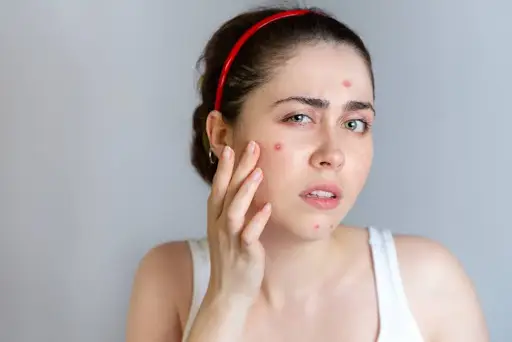Why Do Pimples Appear After a Chemical Peel? Here’s the Reason!
Author: Nulook ExpertiseReview by: -Facial peels are a popular skincare treatment to remove dead skin cells and promote skin regeneration. However, many people wonder: why do pimples appear after a chemical peel? This can happen due to various reasons, from skin purging to irritation caused by exfoliating agents.
If pimples appear after a peel, your skin might be undergoing a natural cleansing process, or it could be experiencing irritation. Understanding the causes will help you address and prevent unwanted side effects. Let’s dive into the details below!
Why Do Pimples Appear After a Chemical Peel?
A chemical peel is a widely used skincare treatment designed to exfoliate dead skin cells and stimulate skin renewal. However, many individuals experience breakouts post-peel, which can be concerning.
This reaction can be completely normal. There are two main possibilities: skin purging and regular breakouts. Purging occurs when the peel accelerates cell turnover, pushing impurities and clogged pores to the surface more quickly. While it may look like acne, this is actually a natural cleansing process. Conversely, a regular breakout happens when the skin reacts negatively to the treatment, leading to inflammation and new pimples.
Causes of Pimples After a Chemical Peel
Several factors can contribute to post-peel breakouts:
1. Increased Cell Turnover
Peels speed up the skin renewal process, causing dead skin cells trapped in pores to surface. This can lead to temporary breakouts before the skin clears up.
2. Weakened Skin Barrier
After a peel, the skin’s protective barrier becomes more vulnerable to bacteria and irritation, making it more prone to breakouts.
3. Pre-Existing Acne-Causing Bacteria
If acne-causing bacteria are already present in your skin, a peel may spread these bacteria, worsening inflammation and triggering new breakouts.
4. Type and Strength of the Peel
Stronger peels containing ingredients like glycolic acid or salicylic acid can cause more intense reactions. The stronger the exfoliation, the higher the risk of irritation and breakouts.
If breakouts become severe or persist for more than a few weeks, consulting a dermatologist is recommended for the best treatment plan.
Read Also: 9 Ways to Effectively Treat Nodular Acne
How to Manage Pimples After a Chemical Peel
If you experience breakouts after a peel, follow these steps to minimize irritation and speed up recovery:
1. Avoid Touching or Popping Pimples
Resist the urge to touch, squeeze, or scratch pimples, as this can worsen irritation and lead to infection.
2. Minimize Sun Exposure
Freshly exfoliated skin is more sensitive to the sun. Always apply sunscreen recommended by dermatologists to protect your skin.
3. Use Gentle and Hydrating Skincare Products
Avoid harsh products containing alcohol or strong chemicals that can dry out your skin. Opt for lightweight, hydrating moisturizers to restore skin balance.
4. Consult a Dermatologist
If breakouts worsen, seek professional advice to determine whether additional treatments are necessary.
Read Also: Why Does Acne Keep Coming Back and How to Deal with It
Post-Peel Skincare Tips
To maintain healthy skin and avoid unwanted reactions, follow these aftercare tips:
1. Use a Gentle Cleanser
After a peel, your skin is more sensitive. Avoid face washes containing alcohol, fragrance, or harsh chemicals that can increase irritation. Instead, use a mild cleanser with soothing ingredients like ceramides or plant extracts.
2. Apply a Soothing Moisturizer
Freshly peeled skin tends to be dry and irritated. Use lightweight moisturizers with hyaluronic acid or aloe vera to keep the skin hydrated and speed up healing. Ensure your moisturizer is non-comedogenic to prevent clogged pores.
3. Avoid Heavy Makeup
Allow your skin time to heal post-peel. Heavy makeup can clog pores and worsen breakouts. If necessary, opt for water-based or non-comedogenic products that are safer for sensitive skin.
4. Always Wear Sunscreen
Peeling increases skin sensitivity to UV damage. Use sunscreen with at least SPF 30 and reapply every few hours to protect your skin.
5. Avoid Additional Exfoliation
Refrain from using AHA, BHA, or retinol for several days after a peel, as they can cause further irritation. Focus on soothing and hydrating skincare to promote recovery.
Breakouts after a chemical peel can occur due to increased cell turnover or irritation. If it's skin purging, pimples will subside within a few weeks. However, if acne worsens, it may indicate a breakout. To manage it, avoid touching pimples, use gentle skincare products, and consult a dermatologist when necessary.
Read Also: Can Pimples Be Popped or Not? Here Are the Facts
Clear and Acne-Free Skin with Nulook’s Acne Facial in Bali!
If you’re struggling with post-peel acne, Nulook’s Acne Facial in Bali is the perfect solution. This specialized treatment is designed to address acne-prone and oily skin using advanced techniques and high-quality products.
Benefits of Nulook’s Acne Facial:
- Deeply cleanses pores
- Removes dead skin cells and blackheads
- Balances oil production and promotes skin renewal
- Reduces acne scars and brightens the complexion
- Hydrates and maintains skin health
Achieve clearer, fresher, and more radiant skin with Nulook’s Acne Facial! Contact us now for a consultation and book your best skincare treatment today!
References:
- https://www.bayoucitydermatology.com/post/how-to-treat-breakouts-after-a-chemical-peel
- https://cosmediclasermd.com/how-to-treat-breakouts-after-chemical-peel/


